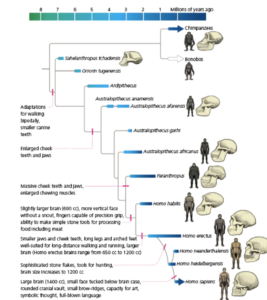“The Bible clearly distinguishes between man and beast- something evolution does not do.”
AIG
Central to the Answers in Genesis thought process regarding mankind is that we are superior beings with complete dominion over all other beasts of the earth. 6,000 years ago, God put us on this earth, exactly the same way we look today. AIG in fact laughs at the evolutionary claim that humans are merely more “highly evolved” than other animals. Yet, the reality is that true evolutionists would not say that humans are more highly evolved. This phrase implies that evolution is a goal-oriented, linear process. Instead, scientists understand that all creatures on this earth have been evolving for billions of years, and each species have developed different traits that enable them to survive efficiently in a unique niche or environment. For instance, imagine a polar bear trying to live in the African savannah or conversely a cold-blooded Gila monster of the southwestern United States surviving in the Arctic tundra. While both of these animals are adapted to flourish in their specific environments, they would not be able to survive in others. This does not make either of them more highly evolved than the other. It may be tempting to claim that our more complex brains and ability to reason, predict, and calculate analytically are proof that we are more highly evolved. The truth is, we are just highly specialized after billions of years of evolutionary forces gave our ancestors advantages for being able to adapt to quickly-changing environments and work together in communities.
AIG devotes much of their time discussing the differences between animals and humans to Biblical scripture. While I will not discount these, I will try to focus on their empirical evidence and scientific points which are more easily proven and addressed. AIG proposes that humans do not share any evolutionary connection to another animal on the earth because the Bible says so. Unfortunately, there is not much evidence provided to support this claim.
AIG attempts to refute existing scientific belief that humans share common ancestors with primates. First of all, they brings up Australopithecus sediba fossils and discuss some of the similarities scientists have found between this species and humans, including longer thumbs, bipedalism, and large brain capacity. However, AIG points out that the radiometric dating proposes it is 2 million years old. Yet, Homo habilis is dated at the same time, accounting for an overlap of 200,000-300,000 between the two species. Therefore, AIG says, how can A. sediba be a human ancestor if it was alive at the same time as H. habilis which is more closely-resembling of humans (larger brain capacity, bipedal, used tools)? This method of attacking science is interesting to me because it seems to use AIG’s own argument that the world is only 6,000 years old against itself. If the world was 6,000 years old, why are they bothering to discuss the overlap in existence of two extinct species 2 million years ago? Conceding their existence at 2 million years ago already disproves their main argument. Regardless, the fact that the two species existed at the same time changes nothing regarding the evolution of humans. Australopithecines shared a common ancestor with the Homo genus, as you can see from the phylogenetic tree below from the University of California, Berkeley. Homo habilis was simply another branch of the Homo family tree and shares a more recent common ancestor than Australopithecines. This does not mean that the two could not have existed at the same time. For instance, Homo sapiens and Homo neanderthalensis existed at the same time before the latter went extinct.

Furthermore, AIG seems hesitant to discuss evidence found that paints a picture of the evolution of mankind over millions of years. For instance, while AIG recognizes Lucy (Australopithecus afarensis), they think that she walked on her knuckles like the “well-designed ape” she was. In the Answers in Genesis creation museum in Kentucky, an exhibit shows A. afarensis with a chimp-like face walking on all fours on her knuckles. This is a perfect example of how they choose to ignore evidence and just present a model that fits according to what they want to believe. AIG chooses to forget the plentiful evidence that suggests that Lucy walked upright like us. For instance, her distal femur is angled relative to her knee joint in such a way that demonstrates bipedalism. It is a trait that enables individuals to balance on one leg during locomotion, seen in humans and not seen in chimp-like apes. The entire pelvis is remodeled into a wider shape that enables for a wider stance- a shape that would not be beneficial for quadrupeds. Further, the spinal curvature shown in her vertebrae is a unique adaptation for bipedal walking- its shape enables upright creatures to balance their center of mass and would be greatly inhibitory to quadrupedal movements. Yet, this is just one example, AIG additionally discounts H. habilis and H. erectus, instead focusing arguments on earlier hominids or Neanderthals. They either seem to think fossils are ape-like or humans exactly. For instance, to explain the similarity between Neanderthal skeletons and human skeletons, they attempt to get around it by claiming Neanderthals are in fact Homo sapiens. While we know that Neanderthals and modern humans shared a common ancestor, the two evolved in parallel and had several distinct features. We now can compare the Neanderthal genome with our own and see that we used to interbreed and some individuals today carry up to 5% Neanderthal genes. Genetic analysis further proves that we are two distinct species, and the Neanderthals did in fact die out once H. sapien migrated into their territories. It seems this is the extent of AIG arguments regarding the origin of mankind.